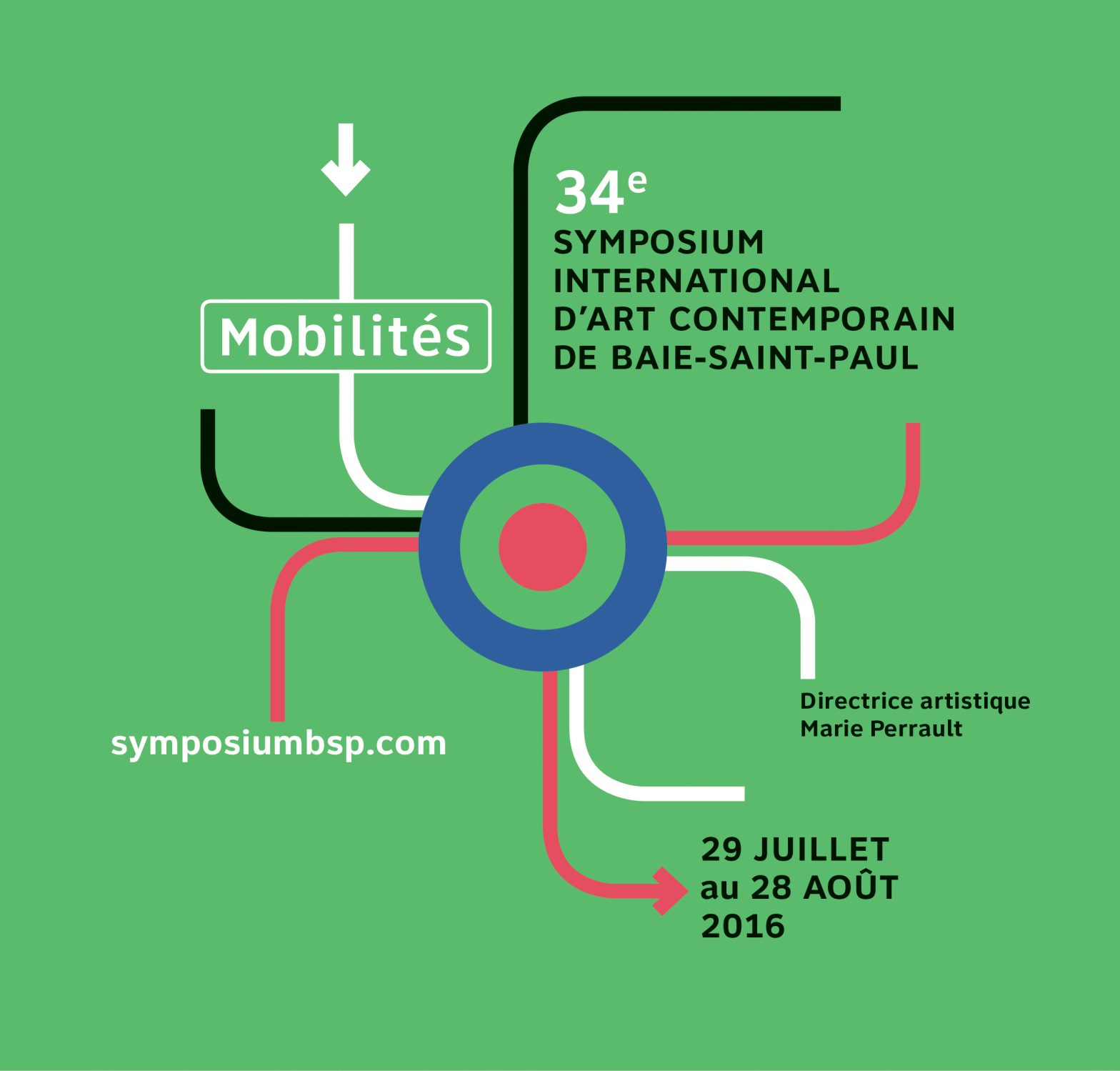In 2016, the 34th Baie-Saint-Paul International Symposium of Contemporary Art, explored phenomena concerned with mobilities and the imaginary motivating it.
The Symposium in two words
The Baie-Saint-Paul International Contemporary Art Symposium is a unique event in Quebec. Each year, for one month, twelve artists from different generations and from various disciplines are invited to create a work in public view around a theme. To the program are added lectures, artist presentations, fun kiosks and screenings related to this theme.
The Symposium, over 30 years
Over the past 30 years, the Symposium has welcomed more than 400 artists from 28 countries in Europe, America, Asia and Africa. The event welcomed renowned artists and served as a springboard for several emerging artists, including Christopher Boyne, Mathieu Cardin, Annie Descôteaux, Anna Hawkins and David Martineau Lachance, during the 2015 edition and whose work was shown more than once since.
Mobilities
Addressing current mobility, this edition of the International Symposium of Contemporary Art of Baie-Saint-Paul is part of a series dealing with changes linked to the development of technologies and started in 2015 with the theme Whispers of everyday life.
Throughout the twentieth century, our societies have been marked by the evolution of transportation and communications, as well as by the development of infrastructure and networks that have made these changes possible. Today, the widespread use of technologies and network connections contribute to a general feeling of circularity. Whether you move yourself or not, mobility plays an important role in our lives.
At the dawn of modernity, artists, including Italian futurists, were fascinated by speed and movement. As a third industrial revolution, anchored in fluidity, begins today, how do artists view this phenomenon, its motivations and its consequences?
The twelve artists selected for the 34th edition of the Symposium explore the imaginary of travel and the phenomena of migration, the movement of objects and goods, means and networks of transport, as well as nomadic communities based on a shared experience of displacement or wandering.
Nicole Bauberger
Whitehorse, Yukon
Nicole Bauberger is a painter who has worked for several years on a series titled Get There From Here, made up of paintings created to the rhythm of one every 50 km of the Trans-Canada Highway, which she has travelled from the Pacific Coast to the Atlantic and from the Far North to southern Canada.
In an unusual but quite legal way, she thus examines the public spaces that are situated along this road network, a huge cultural project to which we will contribute as Canadians and appreciate as travellers. She also produces an ongoing series of encaustic paintings on the dress motif, which she presents in a way that reveals a personal experience of displacement, coming from sensibility to place, independent of the great transportation and communications networks.

During the Symposium, she exhibited 10 paintings made to the east of the crossroads where one exits the Trans-Canada Highway, heading for Baie-Saint-Paul, and 10 paintings showing each of the 50 km to the west of the same spot. From photographs taken in the Charlevoix region, she completed this series with paintings of roads in the surrounding Charlevoix’s area, particularly highways 138 and 362. In addition to this, 100 Dresses for Baie-Saint-Paul were made up as small encaustic paintings inspired by the cultural life of people in the Charlevoix region.
Nicole Bauberger lives and works in Whitehorse. She explores, through painting, the notions of presence and place. A graduate of Trent University in mathematics and English studies, she continued her studies at the Ontario College of Art and then worked as an apprentice in the studio of painter David Bierk. In 2016, she completed a research project on traditional First Nations weaving, with a view to obtaining a diploma in northern studies from Yukon College in Whitehorse.
She has done artist residencies in national parks and in cultural organizations. His works are regularly exhibited in Canada. His participation in the Baie-Saint-Paul International Contemporary Art Symposium was the first presentation of the Get There From Here series in Eastern Canada.
Patrick Beaulieu
Orford (Quebec)
Patrick Beaulieu is a multidisciplinary artist who expresses himself through performative journeys, sculptures, videos, photographs and installations.
For about 12 years, his work has evolved around the experiences and encounters he has had on his poetic, performative peregrinations across North America, Europe and Asia, particularly Méandre, L’échelle de Beaufort––La marche du vent, Transfriable, as well Vegas, Ventury and Vecteur Monarque that he has carried out in collaboration with writers, philosophers, graphic designers and landscape architects. These travels lead to the development of a body of visual work inspired by natural phenomena (winds, tides and migratory cycles), luck, chance or the synchronicity of situations.
At the Symposium, Patrick Beaulieu made a series of short excursions during which he tried to reach imaginary destinations following the directions given by people he came across on the way. By poetically appropriating the place names of the region, he sought to reach these fictitious places, linked to local geography and history. His excursions allowed him to collect or produce traces and documents in the form of short videos, photographs, geopoetic maps and collections of objects.
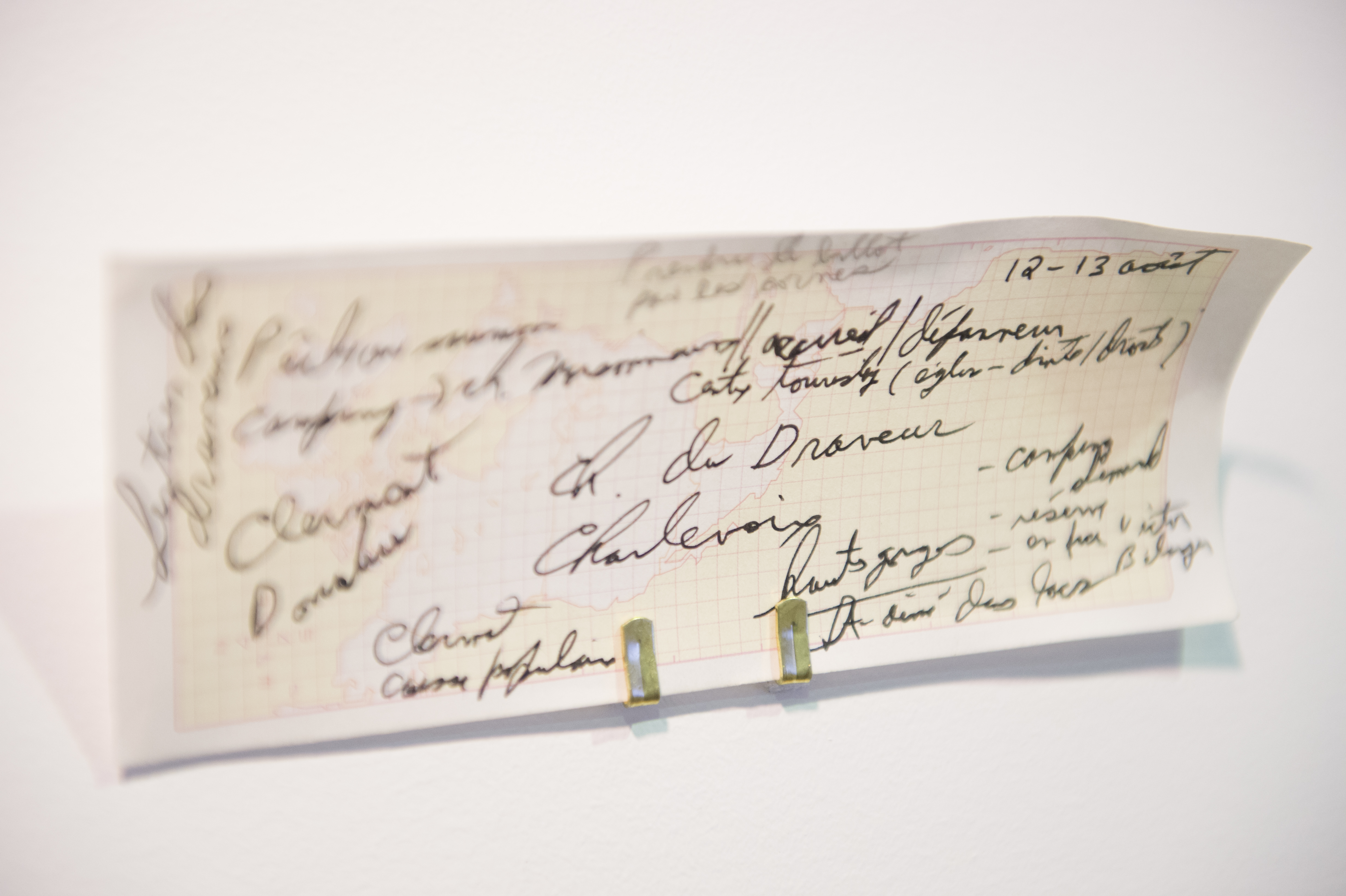
Patrick Beaulieu lives and works in Orford in the Eastern Townships. He holds a BFA in visual art from the Université du Québec à Montréal. For more than 12 years, he has exhibited his work regularly in Canada, Quebec and abroad, particularly in Belgium, France, Singapore and Mexico, a country where he has participated in several artist residencies. He also has produced numerous public art works for schools, libraries, health-care institutions and parks in several Quebec regions. He is represented by Galerie Art Mûr in Montreal.
Camille Bernard-Gravel
Québec City, Québec
Camille Bernard-Gravel is inspired by simple natural phenomena, easily observed on a daily basis or in our immediate environment. Her art research is nourished by her attention to the interactions between water, air and light, as well as to the movements and sounds produced by these elements.
She uses industrial materials or stemming from human activity, to reinterpret natural phenomena such as rain, wind and the reverberation of light, and reproduce their sound qualities. Through videos, installations, kinetic sculptures and audio-visual works, she evokes the intangible character of these epiphenomena.
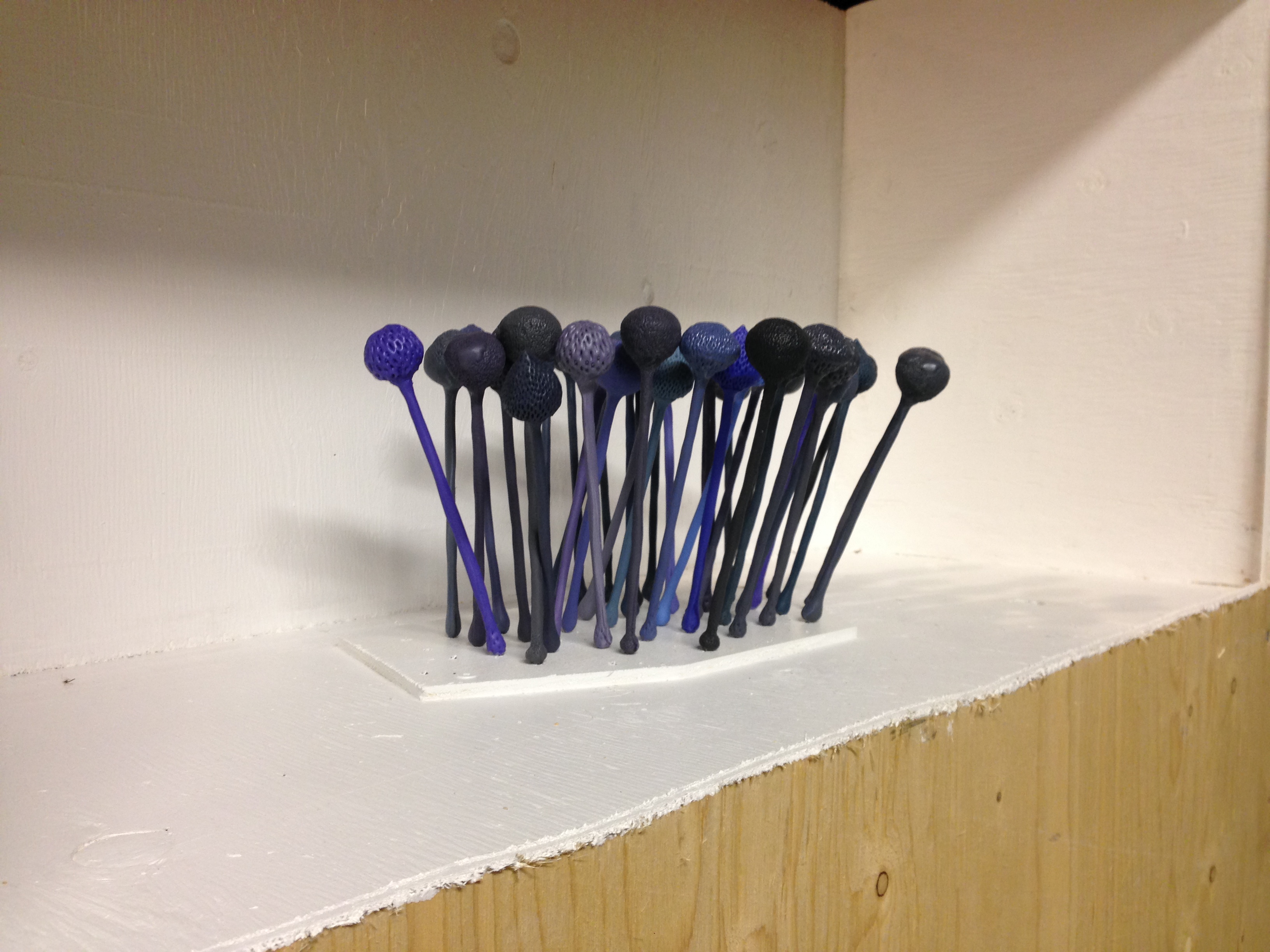
Her work calls upon notions of mechanics and links the elements in a fluid system in a kind of performance, making us aware of the poetry of nature which she perceives as a network of dynamic and mobile interrelations. At the Symposium, she produced kinetic elements inspired by the development of plants and sensitive to the presence of visitors, themselves disturbing elements, within an artificially created bio-mechanical ecosystem.
A native of Quebec, Camille Bernard-Gravel holds a bachelor’s degree in visual and media arts from Laval University. Her work has been the subject of individual exhibitions in Quebec and abroad. His works have also been shown during artist residencies in France, Thailand, and Mexico.
Eveline Boulva
Québec City, Québec
Themes of territory and landscape are central to Eveline Boulva’s art practice. Territory here is defined as a geo-social space in which collective identities and imagination are an integral part. This is the raw material of landscape from which the artist’s subjective perception of natural or humanized spaces is conceived.
Preliminary trips and journeys are an essential part of Eveline Boulva’s creative process. This is when she observes and experiences the territory in order to analyse it and understand its specific character. She then tries to translate and express the intrinsic heterogeneousness and the specificities of these spaces in the form of paintings and drawings, conveyors of a sense of belonging to one’s milieu.
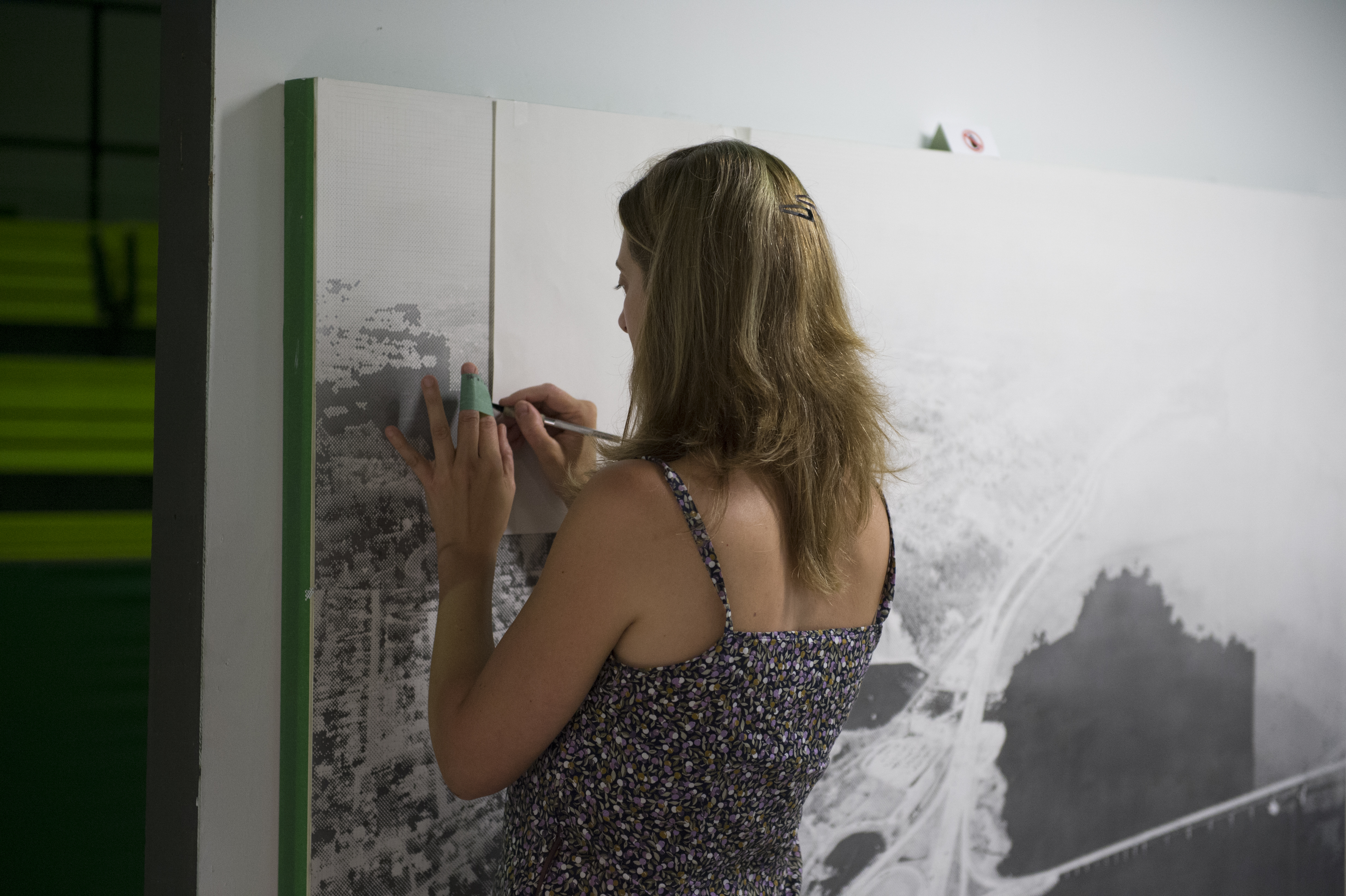
During the Symposium, the artist worked from aerial photographs of the banks of the St. Lawrence River, which she reinterpreted by superimposing multiple painstakingly applied layers of acrylic glaze, ranging from lightly colored gray tinted to glaze colored. Digital matrices isolating each of these shades will be cut out of a vinyl film, serving as a stencil during the application of the successive layers of the pictorial material. In the very production of the paintings, the representation takes on a topographic character where, on the darkest tones applied first, the lightest tones are then superimposed and up to white, gradually constructing reliefs.
Born in Quebec, where she lives and works, EvelineBoulva holds a doctorate from Laval University combining visual arts and geography. She has presented her work in several exhibitions and has also participated in creative residencies in Quebec, Canada and abroad. She has produced several works of public art and her works are part of private or institutional collections. She is represented by Galerie Lacerte.
Samuel Breton
Québec City, Québec
Samuel Breton’s approach is embodied in multimedia animations and collages, where poetry acts as an evocative force allowing us to explore reality.
He juxtaposes and superimposes references to everyday objects and deliberately giving them an enigmatic and poetic sense. To do this, he freely uses traditional mediums, such as drawing and writing, which he combines with animated video. He thus explores the parameters of current culture and that inherited from the past, through image and language, photography and animation.
At the Symposium, he developed a performative video installation inspired by a Nordic clothing icon, the traditional Sorel boot, evocative of walking trips in winter. Around the model designated “Eskimo” dating from the 60s, he questioned this appellation perceived as pejorative by the Inuit, along with our stereotypical perception of their culture. This winter boot has become a true temporal marker of the past. It will enable the artist to broach the theme of mobility at its basic level, as a factory-made article of clothing associated with human walking, at the same time that it poetically relates the outcome of the Europeans’ explorer mobility in America.
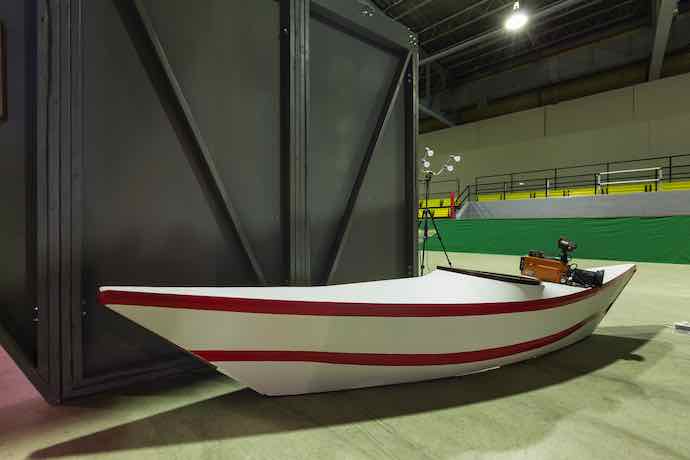
Reproduced in an oversized format on the studio wall, the Sorel boot became a décor, alternately an ice field, dwelling and sea shore in which the artist juggles with the Eskimo stereotype, as a figurine integrated into a staging that is almost burlesque., but critical.
Samuel Breton holds a bachelor’s degree in fine arts from Concordia University (2010) and a master’s degree in visual arts from Laval University (2012). His installations combine drawing, animated cinema and video. Her work has been presented in Quebec and Canada. shortly before the Symposium, he obtained a Première Ovation grant in visual arts for the production of the Owl and Ushanka projects.
Geneviève Chevalier
Eastman (Quebec)
Acting as an artist, curator and academic researcher, Geneviève Chavalier broaches her artistic practice in a conceptual and contextual manner. Her work develops both in the exhibition space and through academic research and critical writing. She is interested in current socio-political and ecological issues related to natural, geographic, institutional or discursive sites.
Making the gallery a place for sensory experience and research, she uses objects, images and text to explore the possibilities that their organized presentation reveals as an exhibition. She is always seeking to expand the boundaries of this staging, in particular through the presentation of object collections and informations gathered at the sites that she explores or studies.

In Baie-Saint-Paul, she carried out research around the issue of seasonal migration of birds, a phenomenon likely to change in the near future. Based on observations made by hiking the Cap de Charlevoix Trail, she drew up an inventory of the bird species present during the summer and studied the route of their migrations, focusing on the modifications of it. because of climate change.
Her final work included material related to her observations (photographs, sketches and audio recordings) and her research (various works, instruments and documents provided by the participants). Cartels offered scientific, poetic and conceptual reflections around the elements presented. The approach also encouraged the participation of the public invited to contribute to the project through personal observations, especially during trips with birdwatchers. In the year following the Symposium, she published Bord d’attaque. Bord de fuite, as a result of a residency in Scotland where she developed the questions addressed at the Symposium.
Geneviève Chevalier is an artist and independent curator. She completed post-doctoral work in museum studies at the École multidisciplinaire de l’image at Université du Québec en Outaouais (UQO). As an artist, she has presented her work in group exhibitions at the Musée Lachine in Montreal and at LŒil de Poisson in Quebec City in 2015, as well as at the 7th edition of Manif d’art in Quebec City in 2014. Her installation Mon Boisé was shown at Maison de la culture Notre-Dame-de-Grace, Montreal in 2016 and Orford: Insular Territory, at the Thames Art Gallery in Chatham, Ontario in 2014.
She published regularly in art magazines and journals and has worked as an exhibition curator. She has participated in residencies for artists and curators at Centre Sagamie in Alma, at the Banff Centre in Alberta and at the Vermont Studio Center in the USA.
Frédéric Cordier
Montréal (Quebec) and Lausanne (Switzerland)
Photographs taken and observations carried out around industrial sites inspire Frédéric Cordier to compose his prints. These visits enable him to absorb the atmosphere of these places and create a landscape, using simplified graphic forms that evoke a certain abstraction and the reproduction of manufactured materials.
These juxtaposed motifs and forms produce an unreal ambience, in which heavy industry is associated with more evanescent visibility phenomena, being rendered as psychedelic motifs and compositions relating to Op art and pointillism.
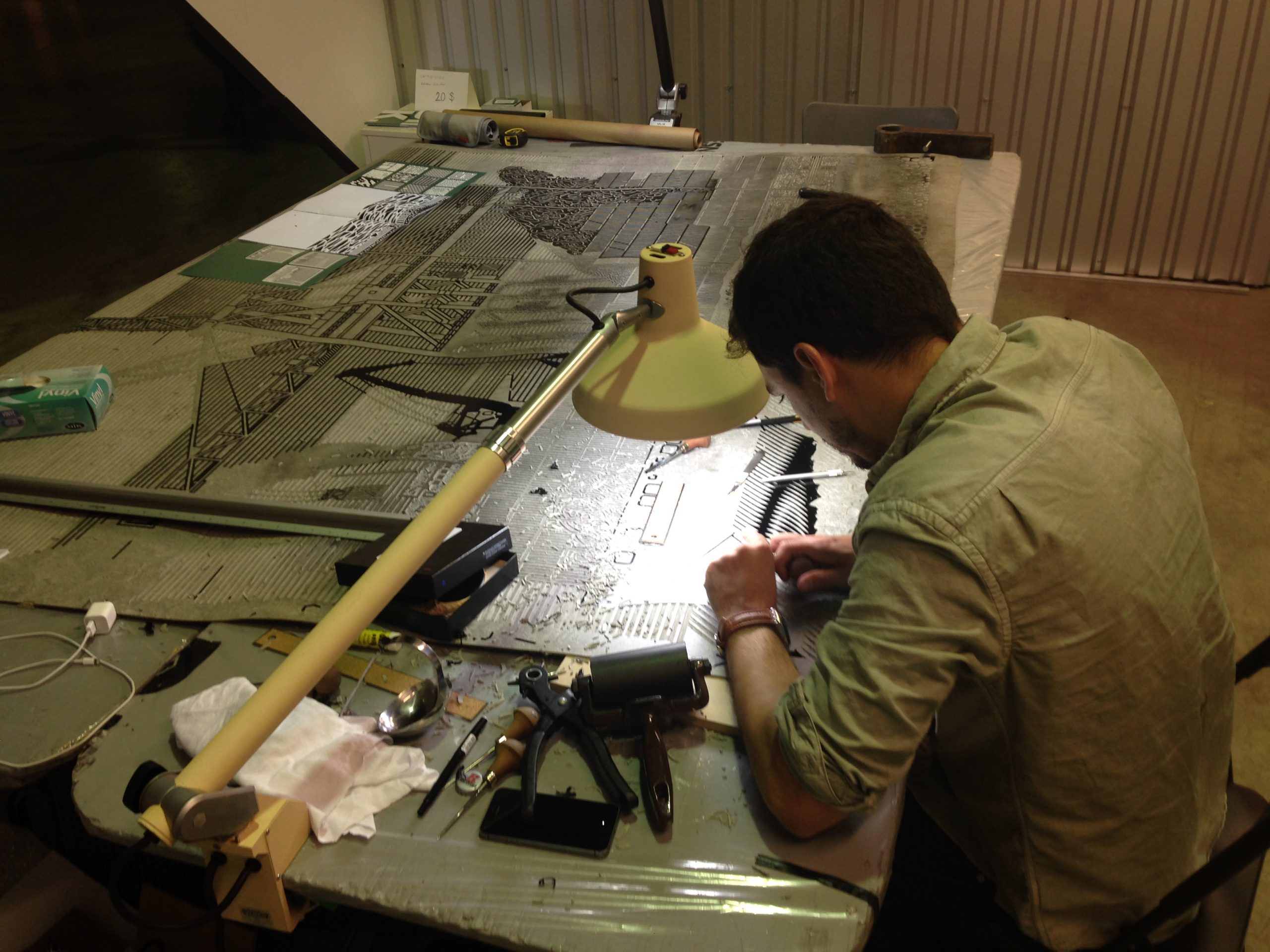
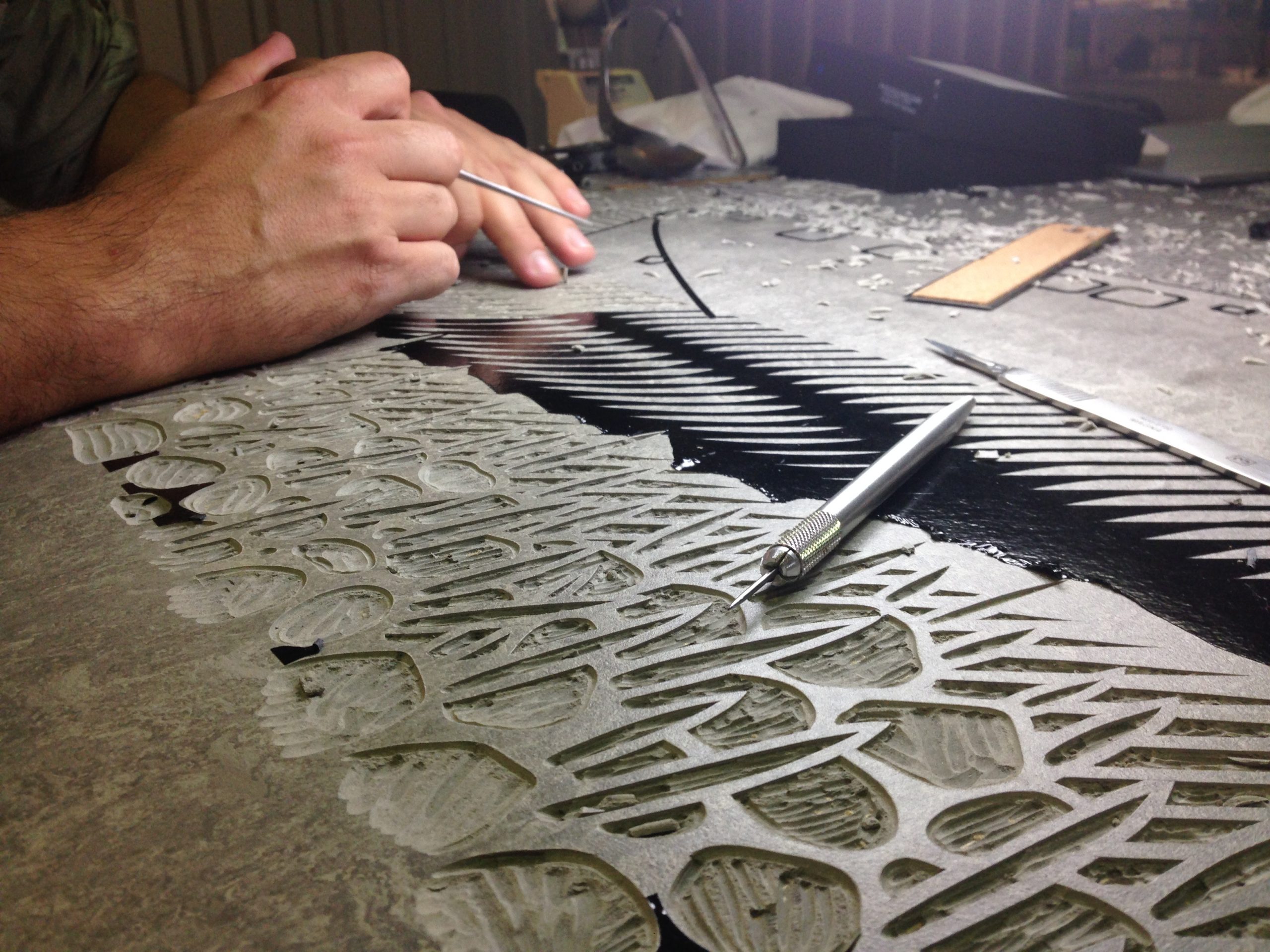
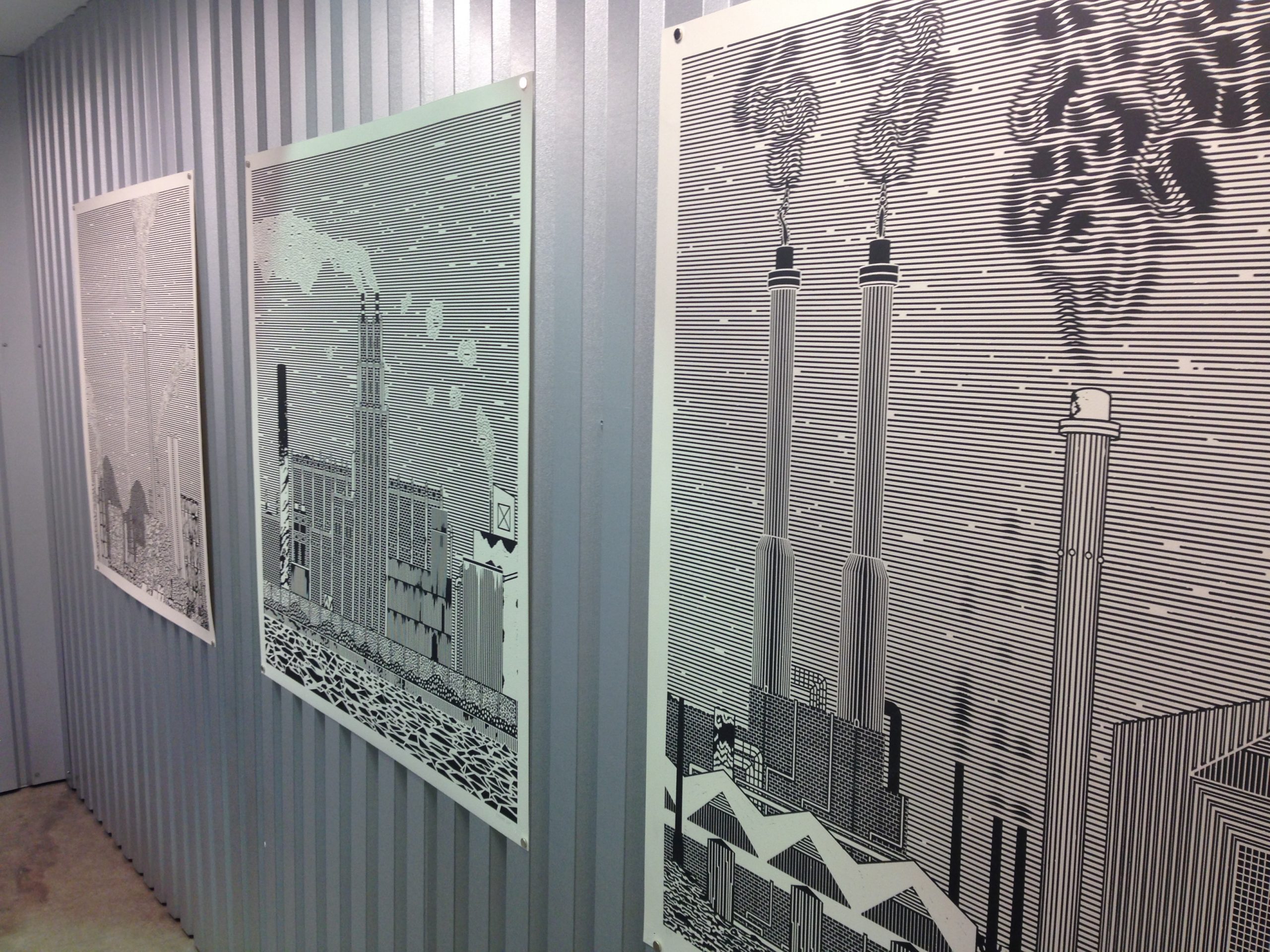
Throughout the Symposium, he created a harbour view, integrating cranes, boats and other machinery into large-scale linocuts on the theme of the container, an icon serving as a pretext to create new motifs and a variety of textures. In contrast to the fixed and immobile infrastructure that the factory represents, the container embodies the mobile modal unit of our modern economy.Conceived of as an easy means of transit, it represents the constant flow of merchandise created by international commercial exchange.This same adaptability also enables it to be transformed into a dwelling during emergency situations, or assembled in the form of architects’ houses, all expressions linked to the conditions of contemporary mobility.
Born in Canada but trained in Switzerland, Frédéric Cordier now lives and works between Montreal and Lausanne. He holds a bachelor’s degree in visual arts from the Cantonal Art School of Lausanne (ECAL). He creates wallpaper installations, notably in the Tell de Montbenon chapel in Lausanne and in disused factories in Tbilisi, Georgia, and in Paris. In 2011, he received a six-month residency at the workshop of the Canton of Vaud, and at the Cité internationale des arts de Paris, where he worked on large linocuts. He has presented several individual exhibitions in Quebec and Europe, notably at the URDLA Center international estampe et livre in Villeurbanne in 2013 and 2014. He is represented by Galerie Laroche / Joncas in Montreal.
Thibault Laget-ro
Grosrouvre (France)
For several years, Thibault Laget-ro has been interested in the concept of freedom and in one person’s experience of it relative to that of another and according to various cultural contexts. His art practice contrasts those who live through events that undermine freedom and their violent consequences, with those who witness these tensions, at a later time several thousand kilometers away in considerable comfort.
To do this, he works in collaboration with war correspondents. This is the way that he has looked at the Israeli-Palestinian conflict, the Arab Spring and, more recently, the war in Syria before this became an international concern. Gradually, the exodus, this ultimate flight to escape death, has become his main concern. Since then, he has endeavoured to trace this journey of crossing the Mediterranean Sea, one of the most perilous and dreaded expanses of water.
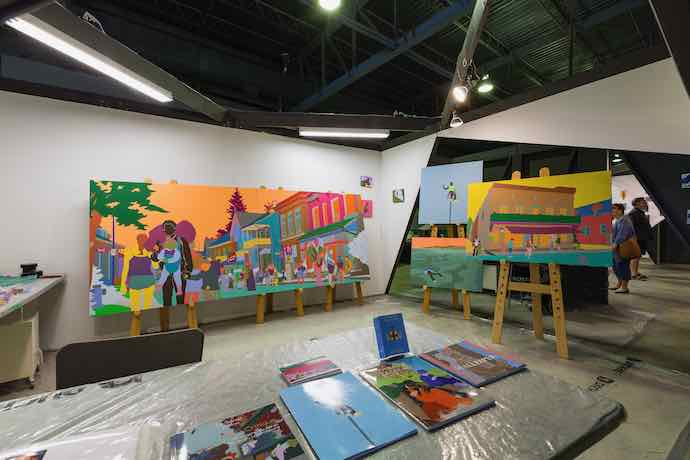
In the context of the Symposium, he explored the notion of pied-à-terre in a very graphic pictorial style. Taking inspiration from ships passing by off the coast of Baie-Saint-Paul and looking atthe streets, beaches and docks, he will imagine these same places receiving a great number of migrant families. Common and well-known places, elements of daily life that are humdrum for some, will be shown as the promise of a better life for others.
In parallel to this imagined scene and taking a more conceptual approach, he will produce a series of 200 passports, documents providing proof of identity, of belonging and the advantage of a certain freedom. Over the course of the event, these 200 passports that “open doors” will be distributed to visitors, giving them the chance to become aware of their privileged position. With time, these documents will become damaged, lost or stolen, and with a little luck they even will cross some borders. This chain will not go on forever and its fading will emphasize that freedom is both invaluable and ephemeral.
Born in Tokyo, Thibault Laget-ro is a figurative painter. He has a degree in economics from Université Sorbonne 1, and was a student in the studios of Hubert de Chalvron and Jean-Marc Thommen at the École normale supérieur des beaux-arts de Paris. He then worked with sculptor Arnaud Kasper and continued his training at a residency in Santa Fe in the United States. Along with his activities as a painter, he published a collection of short stories at Éditions Kalara in 2012. The same year, he received the third Daniel Walter short story prize for another work at the Summerlied Festival.
Michele Mackasey
Saskatoon (Saskatchewan)
As an artist, Michèle Mackasey feels a certain social responsibility and develops her works as many occasions for inclusive collaborations.
When the media and the public are focused on refugees from everywhere in the world, migrants on a global scale, she looks at itinerancy, which is rampant in Canada and in our cities, in order to find a solution to the negligence and disregard that victimize the homeless people we meet everyday.
Thanks to a participation with the Lauberivière, an organization offering a refuge for people in homelessness or at risk of being homeless and a multi-service support center, During the Symposium, Michèle Mackasey produced an installation in the context of her huge project Quartier Souhaits-chez-toits (Wish-Home Neighbourhood) created with the participation of visitors.
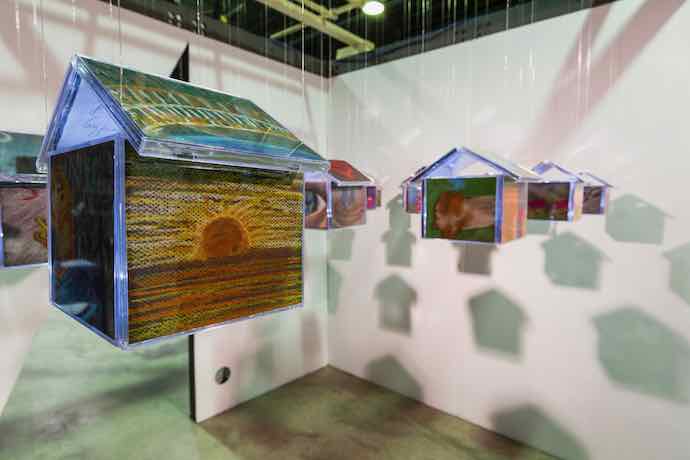
The grouping was composed of small houses made in aid of the homeless. In a certain gesture of empathy, the visitors were invited to draw a dwelling for a family or someone alone, from an account of their own situation. Attached to a grid hanging from the ceiling, the small houses will serve as support for drawings and will be displayed so as to create a small area of the city or a neighbourhood of wish homes, a dream on the way to becoming a reality. A component of the work will be made up of illuminated small houses, the light showing that the dwelling is inhabited. The artist thus contrasts a certain mobility linked to the luxury and privilege of some, with the itinerancy that causes enormous stress daily for people and families who do not have a home.
Born in Chibougamau, Quebec, Michèle Mackasey now lives and works in Saskatoon. In 1991, she completed a fine arts degree with distinction in drawing and painting at the Ontario College of Art and Design. Since then, she has presented her work in solo exhibitions in particular Face à nous at the Mendel Art Gallery in Saskatoon, at Godfrey Den Art Gallery in Yorkton and Grace Campbell Gallery in Prince Albert and then in duo with Joe Fafard in L’art Fransaskois at the Musée de la civilisation in Quebec City. From 2012 to 2014, she had an artist residency to work in the community at the YWCA in Saskatoon. She currentlyis working in collaboration with the Band Council and the members of the English River Dene Nation.
Guillaume-Adjutor Provost
Montréal (Quebec)
Through a certain indeterminism of forms, Guillaume Adjutor Provost’s work probes expressions of the unconscious, notions of the use and construction of ideas. His artistic practice becomes a space for research, a place to examine our relation to contemporaneity: navigating within its deceptions and states of uncertainty. More specifically, he broaches issues on the periphery of what makes history: the counterculture, personal archives, queer theories, the psychedelic state and science fiction.
At the Symposium, he produced a series of psychedelic drawings and produced a performance by Sarah Chouinard-Poirier inspired by a collection of QSL cards, exchanged between truckers during the 1970s-80s and linked to their shortwave radio communications. This communication system testifying to an idiosyncratic culture specific to this community of nomads.
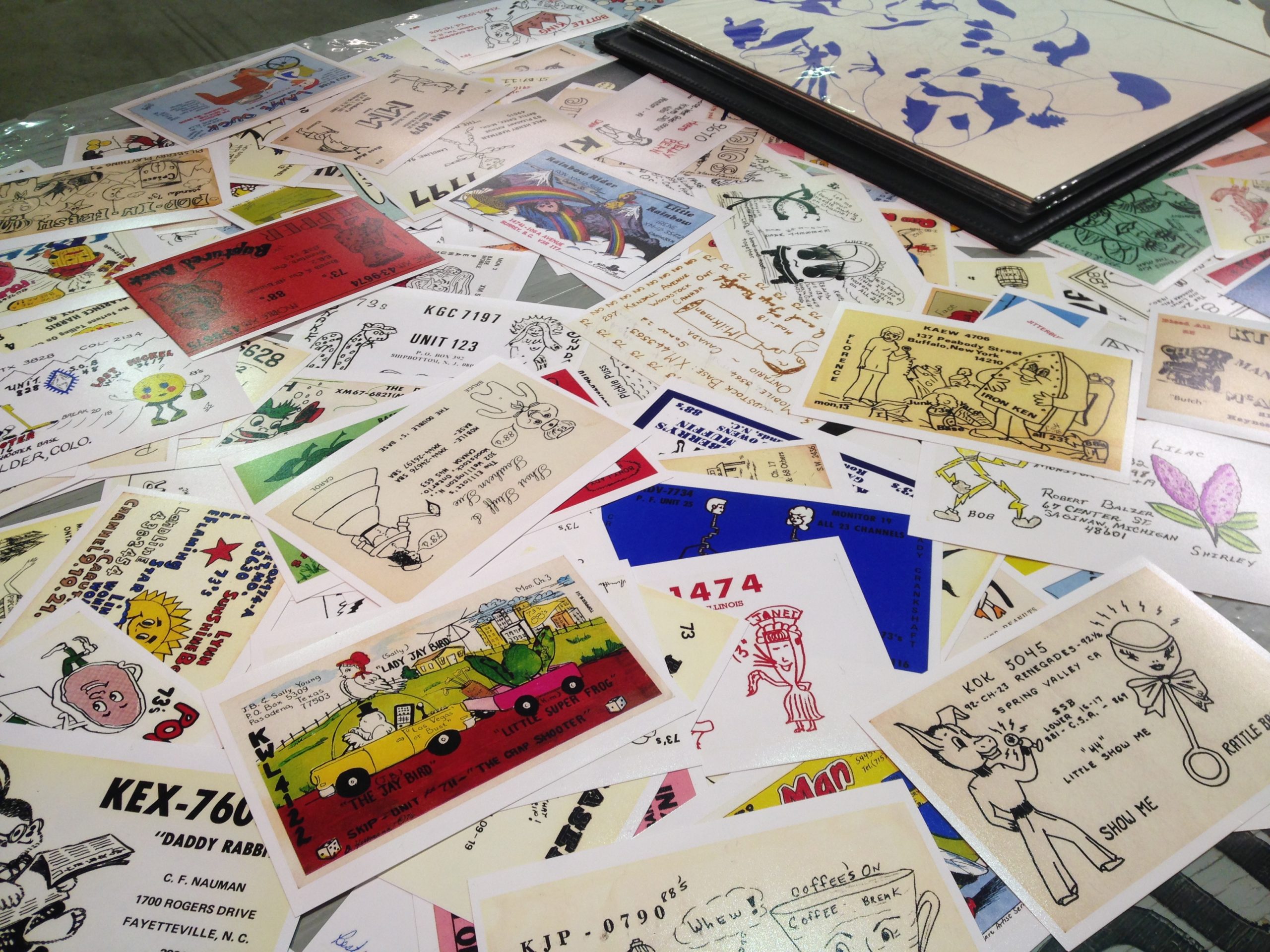
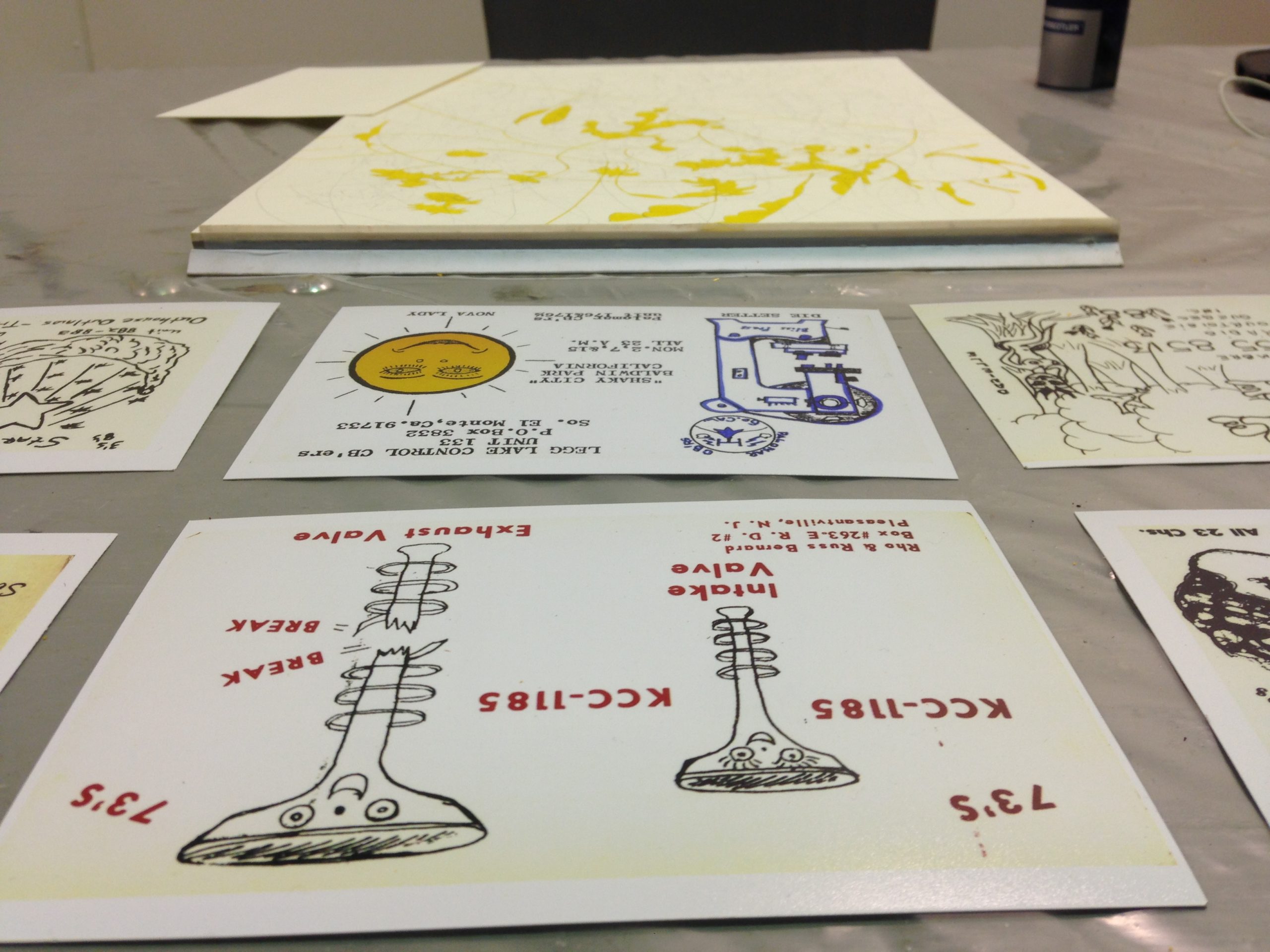

In the early days of broadcasting, the ability of a radio to transmit and pick up distant signals was a source of pride for many passionate users. Similar to postcards, QSL cards then constituted a written confirmation of transmission between two amateur radio operators. These included the coordinates of the transmission frequency, as well as an illustration accompanied by the name or pseudonym of the operator who received the transmission.
Guillaume Adjutor Provost completed a doctorate in study and practice of the arts at the University of Quebec in Montreal in 2017.His research in both the practical and academic fields is concerned with the notion of art curating, namely the use of interdisciplinary approaches to presenting an exhibition as a mode of creation.
His work has been presented in solo and group exhibitions in Canada, at Couvent des Récollets in France and at Fondation Christoph Merian in Switzerland. He has a studio at the Darling Foundry in Montreal. He has also participated in several artist residencies in Canada and abroad. During the 2015 Symposium, he was awarded the Jean-Claude Rochefort grant, highlighting his original contribution the study of contemporary art practices and exhibition curating.
Momar Seck
Geneva (Switzerland) and Dakar (Senegal)
Momar Seck is interested in discarded objects that are seen as essentially worthless, which he then give sa new symbolic charge. The mixing of materials, colours, poetry and numerous effects creates an actual porosity between various cultures and diverse cosmogonies.
His works immerse the viewer in realities of daily life whose rejects and debris evoke memories and traces of origin, as well as the ruptures, displacements and transformations that followed. Beyond appearances, he thus develops a reflection on reality, the singularity of objects, the ingenuity of artists, as well as on interdisciplinarity and the plurality of cultures, where he likes to bring out the playfulness of creation.
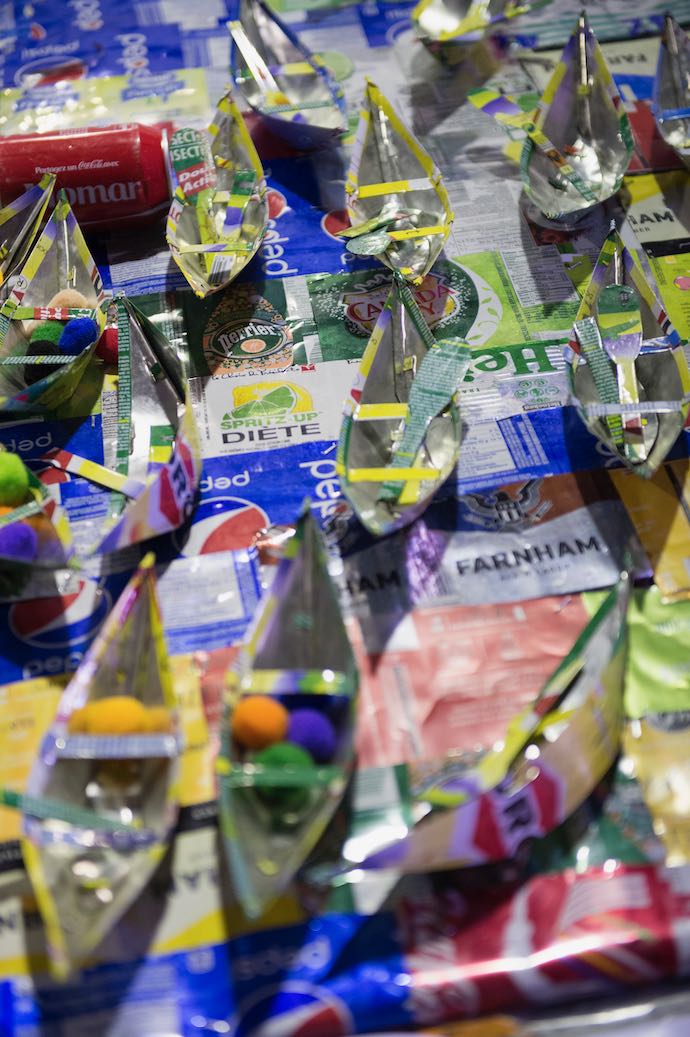
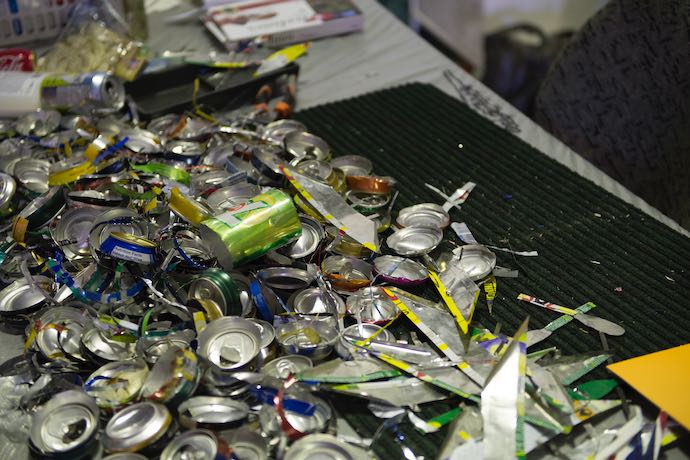
At the Symposium, he invited visitors, to make small boats from recycled materials (old cans of carbonated drinks and various aluminum and light metal containers). These boats were then be painted in various colors and fixed to a more imposing wooden structure, also in the shape of a boat.
His installation was set up as a symbol of movement and the phenomena of mobility, linking the recovery of objects, their trade and the transport of goods by its material, as well as the phenomena of human migration by motif reproduced thanks to an entirely African art of recovery, here reinvented.
Born in Dakar in Senegal, Momar Seck lives and works in Dakar and Geneva in Switzerland. He holds a diploma from the École Normale Supérieure d’Education d’Art in Dakar and the École Supérieure des Beaux-Arts in Geneva. He also completed a doctorate in plastic arts from the University of Strasbourg in France. He has presented his work in individual and group exhibitions in Switzerland, France and Italy as well as in Senegal, Cameroon and Mali. His participation in the International Symposium of Contemporary Art in Baie-Saint-Paul a second presentation of his works in America, after his participation in the 12th biennial of LaHavane in Cuba.
Anne-Sophie Turion
Pantin and Marseille (France)
Anne-Sophie Turion favours forms of fragmented narrative, appearing as so many potential stories and possible situations to explore.
She proceeds with a collage of narrative elements, stemming from distinct states of mind and through the use of artistic techniques borrowed from both theatre and film such as props, stage directions, soundtracks, sound effects and voice off. She works with these codes, and eloquently spoken formulas, that she combines with allusions revealing the holes, gaps and flaws of the initial remarks, into which seep the absurd and the burlesque.
By means of visual suggestionsand performative actions, she attempts above all to reveal the fabrication of our private and collective stories. Her workshighlight the thresholds in which the private and the collective intermingle. The project that she would like to produce during the Symposium is structured around these questions.
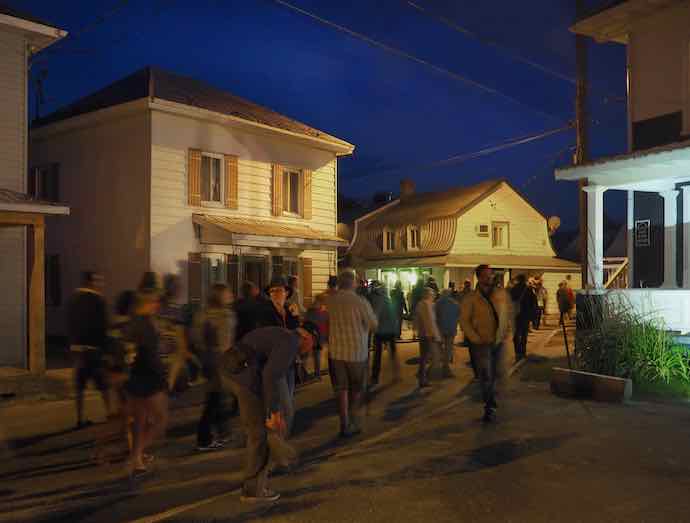
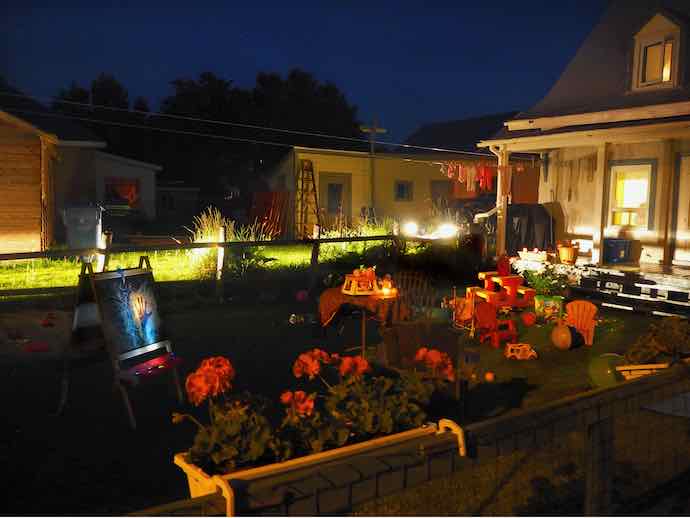

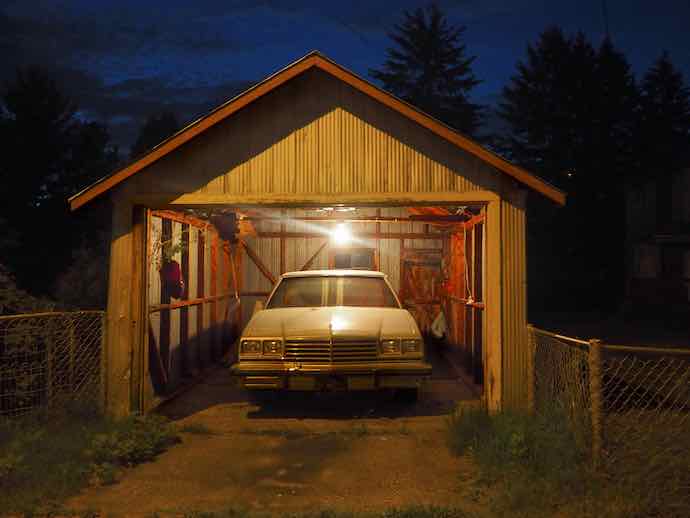
At the Symposium, she produced a set of fictitious commemorative plaques, obliterating a selection of those already in place at various sites in the City of Baie-Saint-Paul. With the collaboration of citizens, especially residents of rue Saint-Adolphe, an old pedestrian street in the heart of the historic village core, she created for an evening a street animation, reproducing cinema scenes to the sound of great film music public broadcast simultaneously on community radio.
Born in Paris, Anne-Sophie Turion received a degree, summa cum laude, in scenography from the École nationale supérieure des arts décoratifs de Paris in 2010. Previously, she studied directing at the Université du Québec à Montréal and design at the École nationale supérieure des arts decorative de Paris. Working on the borders of traditional artistic disciplines, she has created many stage settings and soundscapes as well as art works such as photographs, performances and installations in public spaces. She has exhibited in France at Centre d’art contemporain de la Ferme du Buisson, Noisiel, at Centre d’art de la Villa Arson, Nice, at the Abattoirs, Toulouse and at Friche La Belle de Mai, Marseille, as well as at Centrale Fies, Italy. She also has presented her work at VIVO Media Arts Centre in Vancouver, Canada and inBeijing, China, and has participated in numerousartist residencies in France and abroad.
François Morelli
Honorary President of the 34th Symposium
Honorary President of this edition of the Symposium entitled Mobilities, François Morelli is known for his interest in the concepts of passage, circulation and transformation. He is recognized for his walks performed in urban contexts, notably in Montreal, Vancouver and Berlin, or in the countryside in the Hautes-Laurentides, Wales and continental Europe.
At the Symposium, a small exhibition entitled Passage of Free Electrons was dedicated to him. it brought together drawings, prints and sculptures, pursuing the dream of evolving freely which animates his journeys. The drawings reprsented individuals in ambiguous dynamic interactions, coming as much from complicity as from rivalry. The prints and sculptures from the Belt Heads series consisted of strange puppets, alter ego just as manipulable as manipulative, distant echoes of technological devices, such as the personal computer and the cell phone, on which a mobility experience is anchored. .
The inauguration of the event also welcomed, The indeterminate and the possible in the work of François Morelli – Conversation between François Morelli and his son Didier. In which, Morelli presented his interventions, in the form of strolls, emphasizing the artist’s relationships with society, other individuals and works of art, in an informal discussion with his son.
Renowned artist born in Montreal, François Morelli obtained a bachelor of fine arts from Concordia University in 1975. From 1981 to 1991, he lived in the New York region where he completed a master’s degree at Rutgers University in 1983, before teaching there for a few years. Back in Montreal, he first taught at the University of Quebec in Trois-Rivières and later became a professor at Concordia University. Since 1976, his works were seen in numerous individual and group exhibitions and has been presented as part of performance events.
Also an interdisciplinary artist, Didier Morelli develops a performance practice in the context of doctoral studies at Northwestern University in the United States. His practice takes place in outdoor public spaces, breaking away from the unpredictable but regular flow of everyday life. He explores physical, social, political, linguistic and spatial norms, in order to create a breach allowing a critical perspective of authority.
Nicolas Dickner
Inspirational figure
Nicolas Dickner was born in Rivière-du-Loup, from a middle-class family. He studied visual arts and literature, then worked in information technology. At the turn of the century, he designed databases in Peru, wrote fiction in Germany. In 2005, he published his first novel Nikolski, which launched his career as an author. In 2016, he had signed three novels and four collections of short texts. He currently lives in Montreal with his family.
The original French novel Six Degrees of Freedom, around the friendship between a young girl eager to push the limits of human experience and a hacker seeking to optimize the global circulation of goods, won him the Governor General’s Literary Prize in 2015. As part of the Symposium, he gave a conference where he explained his research approach around the writing of this novel which was the source of inspiration for the Mobilities theme of this edition.
Pierre Bourgault
Storytelling of an artistic navigation practice
An artist from Saint-Jean-Port-Joli and from a family of wood sculptors, Pierre Bourgault is inspired by the great outdoors and his personal experiences as a sailor. For several years, he has devoted himself to a series of large drawings made by boat on the St. Lawrence or Hudson rivers.
His conference focused on the purpose and sources of inspiration for his works, in particular La flèche sur la rivière du Gouffre (Arrow on the Rivière du Gouffre), the large drawings and the construction of blocks of salt on the St. Lawrence River and its estuary, and the videos documenting sailing on the Hudson River, which h interprets as following the theories of automatic painters.
Atelier SILEX from Trois-Rivières
Mobile kiosks by Isabelle Gauvin and Henri Morissette
In the parking area of the arena hosting the Symposium, l’Optométriste factice (Dummy Optometrist) Isabelle Gauvin performed eye exams on consenting visitors, using glasses revealing a unique vision of the world, while La Roulotte à Bobby (Bobby Mobile Shack) presented by Henri Morissette proposed sculptural snacks made of heterogeneous objects and tools recovered.
Marie-Christiane Mathieu
Musique de char / Toujours plus à l’ouest (Car music / Always further west)
In her conference Marie-Christiane Mathieu explained the concepts surrounding her itinerant practice in her project Musique de char /Toujours plus à l’ouest. She presented some audio and video archives of the project, collected on the 10,000 kilometers traveled between Fogo Island in Newfoundland and Vancouver Island, as well as the works that emerged during this journey.
Artist and professor at the School of Visual Arts at Laval University, Marie-Christiane Mathieu lives and works between Montreal and Quebec.

